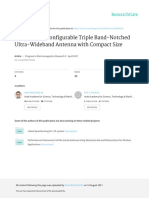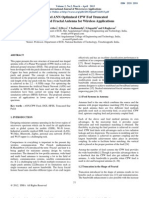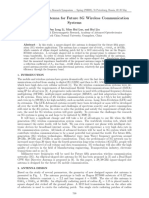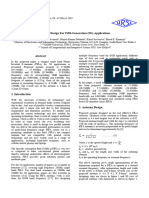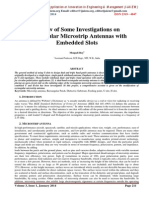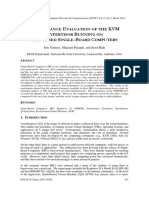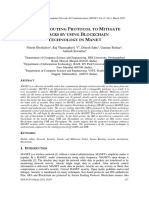N Ovel Designs of B Roadband P Atch A Ntenna For W Ireless C Ommunication A Pplication (1800 MHZ and 2400 MHZ)
N Ovel Designs of B Roadband P Atch A Ntenna For W Ireless C Ommunication A Pplication (1800 MHZ and 2400 MHZ)
Uploaded by
AIRCC - IJCNCCopyright:
Available Formats
N Ovel Designs of B Roadband P Atch A Ntenna For W Ireless C Ommunication A Pplication (1800 MHZ and 2400 MHZ)
N Ovel Designs of B Roadband P Atch A Ntenna For W Ireless C Ommunication A Pplication (1800 MHZ and 2400 MHZ)
Uploaded by
AIRCC - IJCNCOriginal Title
Copyright
Available Formats
Share this document
Did you find this document useful?
Is this content inappropriate?
Copyright:
Available Formats
N Ovel Designs of B Roadband P Atch A Ntenna For W Ireless C Ommunication A Pplication (1800 MHZ and 2400 MHZ)
N Ovel Designs of B Roadband P Atch A Ntenna For W Ireless C Ommunication A Pplication (1800 MHZ and 2400 MHZ)
Uploaded by
AIRCC - IJCNCCopyright:
Available Formats
International Journal of Computer Networks & Communications (IJCNC) Vol.7, No.
3, May 2015
NOVEL DESIGNS OF BROADBAND PATCH
ANTENNA FOR WIRELESS COMMUNICATION
APPLICATION (1800 MHZ AND 2400 MHZ)
Melad Olaimat, Aws Al-Qaisi
Communication Technology Engineering Department, Faculty of Engineering
Technology
Al-Blaqa'a Applied University, Amman, Jordan
ABSTRACT
In this paper, three novel designs of broadband patch antenna are proposed. The first design propose
broadband slotted equilateral triangular patch antenna (ETPA) operating on frequency around 1800 MHz.
The second design propose broadband slotted right angle isosceles triangular patch antenna RAITPA
operating on frequency around 2400 MHz. The third design proposes wideband V-Slotted and shorted edge
ETPA antenna operating on frequency around 2400 MHz. The two powerful software HFSS and IE3D are
used to simulate the proposed designs. Very good agreement between HFSS and IE3D software is obtained.
The designs were chosen to fit modern wireless communication applications operate at Industrial Scientific
Medical (ISM) bands such as Wireless local area networks (WLAN). Moreover, mounting the patch on
thick substrate with loaded slot technique and loading the patch with a notch technique were used to
enhance the bandwidth of those designs. Hence, large fractional bandwidth is obtained.
.
KEYWORDS
Triangular microstrip antenna, slotted antenna, broadband antenna, notch antenna, wireless application,
substrate
INTRODUCTION
Microstrip antennas consist of a patch of metallization on a grounded substrate. They are lowprofile, lightweight antennas, most suitable for aerospace and mobile applications. Microstrip
antennas have matured considerable during the past 35 years, and many of their limitations have
been overcome [1]. Many of the antenna applications for satellite links, mobile communications,
and wireless local-area networks impose constraints on compactness, dual-frequency operation,
frequency agility, polarization control, and radiation pattern control. These functions can be
achieved by microstrip antennas, and hence these antennas are becoming more commonly used
[1]. Among the shapes that attracted much attention lately is the triangular shaped patch antenna
[2]-[13]. This is due to their small size compared with other shapes like the rectangular and
circular patch antennas. It is well-known that microstrip antennas are very narrow band, about
several percent for a typical bandwidth. Therefore, bandwidth enhancement is usually demanded
for practical applications [14]. Thus, bandwidth enhancement is becoming one of the major
design considerations for practical applications of microstrip antennas. To meet bandwidth
DOI : 10.5121/ijcnc.2015.7312
161
International Journal of Computer Networks & Communications (IJCNC) Vol.7, No.3, May 2015
requirement, many bandwidth-enhancement or broadband techniques for microstrip antennas
have been recently reported [14]. Decreasing the quality factor of the microstrip antenna is an
effective way of increasing the antennas impedance bandwidth. This kind of bandwidthenhancement technique includes the use of a thick air or foam substrate. For feeding using a
probe feed, a large reactance owing to the long probe pin in the thick substrate layer is usually a
problem in achieving good impedance matching over a wide frequency range. To overcome this
problem associated with probe-fed microstrip antennas, it was reported that by embedding a Ushaped slot in the patch, the impedance bandwidth of a probe-fed microstrip antenna with a thick
air substrate can easily be enhanced [12]. In this paper, the designs are simulated using two
powerful softwares. Wide range of frequencies is obtained. More enhancements obtained
compared with previous designs. This paper can be divided into five sections. In Section II,
broadband slotted equilateral triangular patch antenna (ETPA) is designed and simulated. This
proposed design is used for Wireless Applications (around 1800 MHz). In Section III, broadband
slotted right angle isosceles triangular patch antenna (RAITPA) is proposed. The proposed design
will operate a round 2400 MHz which is used for Wireless applications. In Section IV, wideband
V-slotted and shorted edge ETPA for wireless communication applications (around 2400 MHz) is
proposed and simulated. Section V presents the comparison between all proposed design and
pinch mark design in [13]. In Section VI present a conclusion of all results.
2. BROADBAND SLOTTED EQUILATERAL TRIANGULAR PATCH ANTENNA
(ETPA) (AROUND 1800 MHZ)
It was demonstrated that, loading the patch with a U-shaped slot will enhance the bandwidth [13].
Figure 1 shows a proposed ETPA, loaded with slots. In this design, two techniques are exploited
to obtain broadband operation. In the first technique the patch on thick substrate is mounted with
loaded slot. In the second technique the patch is loaded with a notch which enhances the
bandwidth. By combining both techniques, a broadband antenna that operates in frequencies
ranging from 1530 MHz to 1870 MHz is obtained as shown in Figure 2. It can be seen from
Figure 2 that the proposed design has a bandwidth of 340 MHz, and a center frequency of 1700
MHz, which implies that a fractional bandwidth of 20% can be obtained. Moreover, it can be
noted that this design can fit wireless communication application.
Figure 1: Geometry of our proposed broadband slotted ETPA; a=9.1 cm, h=1.43 cm, r=1.07, dp=2.125 cm,
w1=0.6 cm, w2=0.4 cm, w3=0.25 cm, l1=2.85 cm, l2=3.89 cm, l3=3.72 cm, and b=1.05 cm.
162
International Journal of Computer Networks & Communications (IJCNC) Vol.7, No.3, May 2015
Figure 2: Simulated reflection coefficient of our proposed design shown in Figure 1 [IE3D].
For the sake of justification, this design is simulated again using HFSS simulator as shown in
Figure 3. It can be noted from Figure 4 that a very good agreement between both simulators is
obtained
Figure 3: Simulated reflection coefficient of our proposed design shown in Figure 1 [HFSS].
Figure 4: Comparison between HFSS and IE3D results for the design shown in Figure 1.
For the sake of justification, the radiation pattern of this design is studied at three different
frequency values within the operating band. Specifically, Figures 5-7 show the radiation patterns
at 1575 MHz, 1680 MHz, and 1800 MHz. It can be noted that the pattern is almost the same at
the three frequencies. In these figures, the beam in the =90o plane gets a bit tilted from
broadside as the frequency increases.
163
International Journal of Computer Networks & Communications (IJCNC) Vol.7, No.3, May 2015
3. BROADBAND SLOTTED RIGHT ANGLE ISOSCELES TRIANGULAR PATCH
ANTENNA RAITPA FOR WIRELESS APPLICATIONS (AROUND 2400 MHZ)
Another broadband patch antenna is proposed to fit with the bands of wireless communication
applications. The proposed antenna is a RAITPA loaded with slots, mounted on a thick foam
substrate (r =1.07), and fed, using probe-feed at dp as shown in Figure 8.
Figure 8: Geometry of the proposed broadband slotted RAITPA; h=14.3 mm, r =1.07, w1=5 mm, w2=3
mm, w3=6 mm, w4=4 mm, l=17.5 mm, and dp=5 mm.
From Figure 9, it can be seen that this patch operates at frequencies ranging from 2463 MHz to
2948 MHz, with bandwidth equal to 485 MHz. Again, this design is simulated using HFSS
simulator for the sake of justification.
164
International Journal of Computer Networks & Communications (IJCNC) Vol.7, No.3, May 2015
Figure 9: Simulated reflection coefficient of our proposed design shown in Figure 8 [IE3D].
Figure 10 shows the simulated reflection coefficient using HFSS. The obtained results, using both
simulators, are close to each other as shown in Figure 11.
Figure 10: Simulated reflection coefficient of our proposed design shown in Figure 8 [HFSS].
Figure 11: Comparison between HFSS and IE3D results for design shown in Figure 8.
165
International Journal of Computer Networks & Communications (IJCNC) Vol.7, No.3, May 2015
The radiation pattern of this design is studied at three different frequencies. From Figures 12-14,
it can be noted that the pattern is almost the same at the three frequencies. In these figures, the
beam in the =90o plane gets a bit tilted from broadside as the frequency increases.
4. PROPOSED WIDEBAND V-SLOTTED AND SHORTED EDGE ETPA
ANTENNA FOR WIRELESS COMMUNICATION APPLICATIONS (AROUND 2400
MHZ)
A new design of Wideband V-Slotted and Shorted Edge ETPA Antenna is proposed for Wireless
Communication Applications. Figure 15 shows the geometry of the design. In this design, two
techniques are combined. Namely, shorting the edge and loading V-slots on the patch. This
combination allows obtaining a wideband antenna that operates at frequencies ranging from 2070
MHz to 2714 MHz, with bandwidth equal to 644 MHz, and center frequency equal to 2392 MHz,
as shown in Figure 16. So, a fractional bandwidth of approximately 27% can be achieved. It can
be noted that this design can be used for wireless communication applications, especially,
WLANs and ISM, which operate at frequencies ranging from 2400 MHz to 2484 MHz.
Figure 15: Geometry of our proposed wideband V-slotted ETPA; h=6 mm, r =4.6, w=3.8
166
International Journal of Computer Networks & Communications (IJCNC) Vol.7, No.3, May 2015
Figure 16: Simulated reflection coefficient of the design shown in Figure 15 [IE3D].
The radiation pattern of this design is studied at three different frequencies. From Figures 17-19,
it can be noted that the pattern is almost the same at the three frequencies. The radiation is in the
broadside direction in the =0o plane, while it is titled approximately 45o in the =90o plane.
5. COMPARISON
Figure 20 shows a comparison between result obtained from reference [13] and result obtained
from proposed design in figure 1. As shown in the figure more bandwidth can be obtained in the
proposed design. It can be seen that the proposed design has a bandwidth of 340 MHz, and a
center frequency of 1700 MHz, which implies that a fractional bandwidth of 20% can be
obtained, whereas the obtained bandwidth in [13] is 308 MHz and a center frequency of 1677
MHz, which implies that a fractional bandwidth of 18.3%. It can be noted, first proposed design
is better than the design proposed in [13] in terms of bandwidth and fractional bandwidth.
167
International Journal of Computer Networks & Communications (IJCNC) Vol.7, No.3, May 2015
Figure 20: Comparison between result obtained from reference [13] and result obtained from proposed
design in figure 1.
Figure 21 shows a comparison between results obtained from second and third proposed designs.
It can be depicted that both designs are operated around 2400 MHz. Moreover, by using ETPA,
more bandwidth can be obtained.
Figure 21: Comparison between results obtained from second and third proposed designs.
Table 1 shows a center frequency, bandwidth and fractional bandwidth for all designs which
summarize all the results mentioned above.
Table 1: Comparison of Center frequency, bandwidth and fractional bandwidth for all designs.
Design
Reference
[13]
1st Design
2nd Design
3rd Design
Center
Frequency
(fc)
(MHz)
Bandwidth
(BW)
(MHz)
Fractional
Bandwidth
(BW/fc)*100%
1677
308
18.3%
1700
2705.5
2392
340
480
644
20%
17.9%
27%
168
International Journal of Computer Networks & Communications (IJCNC) Vol.7, No.3, May 2015
6. CONCLUSION
In this paper, three new designs that fit modern wireless communication application, which
operate at 1800MHz and 2400 MHz, are suggested and simulated using powerful software. The
design is justified by comparing between two software tools (HFSS and IE3d) results and great
agreement is obtained. Good result obtained compared with those obtained in [13]. Wider
bandwidth is obtained which can be fit for new generations of wireless communication that
require wider bandwidth.
REFERENCES
[1]
[2]
[3]
[4]
[5]
[6]
[7]
[8]
[9]
[10]
[11]
[12]
[13]
[14]
R. Garg, P. Bhartia, I. J. Bahl, and P. Ittipiboon, Microstrip Antenna Design Handbook, Artech House,
Boston. London, 2001.
M. M. Olaimat and N. I. Dib, A Study of 15-75o-90o Angles Triangular Patch Antenna, Progress In
Electromagnetics Research (PIER), Vol. 21, 2011, pp. 1-9.
M. M. Olaimat and N. I. Dib, Improved Formulae for the Resonant Frequencies of Triangular
Microstrip Patch Antennas, International Journal of Electronics, Vol. 98, No. 3, March 2011, pp. 407
424.
J. S. Dahele and K. F. Lee, On the Resonant Frequencies of the Triangular Patch Antenna, IEEE
Trans. Ant. Propagat., Vol. AP-35, No. 1, Jan. 1987 pp. 100-101.
J. Helszajn and D. S. James, Planar Triangular Resonator with Magnetic Walls, IEEE Trans. on
Microwave Theory and Techniques, Vol. MTT-26, 1978, pp. 95-100.
D. Karaboga, K. Guney, A. Kaplan, and A. Akdagli, A New Effective Side Length Expression
Obtained Using a Modified Tabu Search Algorithm for the Resonant Frequency of a Triangular
Microstrip Antenna , Int J RF and Microwave CAE, Vol. 8, Issue 1, Dec. 1998, pp. 4-10.
I. J. Bahl and P. Bhartia, Microstrip Antennas, Artech House, Dedham, MA, Chap. 4, 1980.
W. Chen, K. F. Lee, and J. S. Dahele, Theoretical and Experimental Studies of the Resonant
Frequencies of the Equilateral Triangular Microstrip Antenna, IEEE Trans. Ant. Propagat., Vol. AP40, No. 10, Oct. 1992, pp. 1253-1256.
R. Garg and S. A. Long, An Improved Formula for the Resonant Frequency of the Triangular
Microstrip Patch Antenna, IEEE Trans. Ant. Propagat., Vol. AP-36, 1988, p. 570.
Nasimuddin, K. Esselle, and A. K. Verma, Resonant Frequency of an Equilateral Triangular
Microstrip Antenna, Microwave and Optical Technology, Vol. 47, No. 5, Dec 2005, pp. 485-489
D.Guha and J.Y. Siddiqui, Resonant frequency of equilateral triangular microstrip patch antenna with
and without air gaps, IEEE Trans. Antennas Propagate, vol. 52, no.8, Aug. 2004, pp. 2174-2177.
Wong K, Compact and Broadband Microstrip Antennas, John Wiley & Sons; 2002.
Kin-Lu W, and Wen-Hsiu H. Broadband Triangular Microstrip Antenna with U-Shaped Slot,
Electronic Letters, vol. 33, 1997, pp. 2085-2087
R. Mudgal and L. Shrivastava, Study of compact and wideband microstrip U-slot patch antenna
with DGS for satellite applications International Journal of Advanced and Innovative Research, Vol.
3, 2014, pp. 54-56
169
You might also like
- Lab 1 Foot Printing and ReconnaissanceDocument220 pagesLab 1 Foot Printing and Reconnaissancefawas hamdi50% (2)
- CSP Inst Maint Diag r2 PDFDocument4 pagesCSP Inst Maint Diag r2 PDFsteam100deg8229No ratings yet
- CompTIA A+ Certification PracticeDocument637 pagesCompTIA A+ Certification Practicecostasn100% (1)
- RMSA 1800 and 2600Document11 pagesRMSA 1800 and 2600amar rouibahNo ratings yet
- research paper_kDocument11 pagesresearch paper_kkartiksinghal224No ratings yet
- V5i3 Ijertv5is030037Document5 pagesV5i3 Ijertv5is030037Ramya RNo ratings yet
- An Approach To Design and Optimization of WLAN Patch Antennas For Wi-Fi ApplicationsDocument6 pagesAn Approach To Design and Optimization of WLAN Patch Antennas For Wi-Fi Applicationsvietnguyen_93No ratings yet
- Single Layer Monopole Hexagonal Microstrip Patch Antenna For Direct Broadcast Satellite (DBS) SystemDocument6 pagesSingle Layer Monopole Hexagonal Microstrip Patch Antenna For Direct Broadcast Satellite (DBS) SystemInternational Journal of computational Engineering research (IJCER)No ratings yet
- Performance Analysis of Microstrip Patch Antenna by Varying Slot Size For UMTS ApplicationDocument5 pagesPerformance Analysis of Microstrip Patch Antenna by Varying Slot Size For UMTS Applicationsiva1427No ratings yet
- Design of Compact Printed Antenna For Umts & Wimax ApplicationsDocument4 pagesDesign of Compact Printed Antenna For Umts & Wimax ApplicationsIJERDNo ratings yet
- Beprl 2004 1308162 PDFDocument4 pagesBeprl 2004 1308162 PDFsiva1427No ratings yet
- (Book 7) Harry Potter and The Deathly HallowsDocument11 pages(Book 7) Harry Potter and The Deathly HallowsRaviShankarNo ratings yet
- A New Miniaturized Patch Antenna For WirelessDocument5 pagesA New Miniaturized Patch Antenna For WirelessrocinguyNo ratings yet
- Design of A Compact Circular Microstrip Patch Antenna For Wlan ApplicationsDocument11 pagesDesign of A Compact Circular Microstrip Patch Antenna For Wlan ApplicationsijansjournalNo ratings yet
- Enhanced Bandwidth Multiband Slot Antenna For Portable DevicesDocument4 pagesEnhanced Bandwidth Multiband Slot Antenna For Portable DevicesInternational Journal of Research in Engineering and TechnologyNo ratings yet
- Design and Simulation of Microstrip Patch Arrayantenna For Wireless Communications at 24 GHZDocument5 pagesDesign and Simulation of Microstrip Patch Arrayantenna For Wireless Communications at 24 GHZdeepaneceNo ratings yet
- Con and FuturescopeDocument4 pagesCon and FuturescopeShivkant ThakurNo ratings yet
- Antenna ResearchDocument8 pagesAntenna ResearchKishor.ece. anuNo ratings yet
- Mimo Antenna Design ThesisDocument9 pagesMimo Antenna Design Thesisjenniferlandsmannneworleans100% (2)
- Multiband Fractal Planar Inverted F An-Tenna (F-Pifa) For Mobile Phone ApplicationDocument22 pagesMultiband Fractal Planar Inverted F An-Tenna (F-Pifa) For Mobile Phone ApplicationAnonymous C6Vaod9No ratings yet
- Design and Analysis of MIMO Patch Antenna For 5G Wireless Communication SystemsDocument16 pagesDesign and Analysis of MIMO Patch Antenna For 5G Wireless Communication SystemsAIRCC - IJCNCNo ratings yet
- Pifa Slot2Document4 pagesPifa Slot2Guadalajara JaliscoNo ratings yet
- CPW Fed Inverted U-Shape Microstrip Patch Antenna For WLAN/WiMAX ApplicationsDocument4 pagesCPW Fed Inverted U-Shape Microstrip Patch Antenna For WLAN/WiMAX ApplicationsEditorijer IjerNo ratings yet
- Microstrip Patch Antenna With Aperture Coupler Fed at 5.8GHzDocument6 pagesMicrostrip Patch Antenna With Aperture Coupler Fed at 5.8GHzNadira RaihanNo ratings yet
- 1 PBDocument7 pages1 PBRachid DakirNo ratings yet
- Design and Fabrication of Microstrip Patch Antenna at 2.4 GHZ For WLAN Application Using HFSSDocument7 pagesDesign and Fabrication of Microstrip Patch Antenna at 2.4 GHZ For WLAN Application Using HFSSmaleeha khanNo ratings yet
- Compact Cpw-Fed Antenna With Semicircle On Two Rectangular Patches For Wlan ApplicationDocument6 pagesCompact Cpw-Fed Antenna With Semicircle On Two Rectangular Patches For Wlan ApplicationSudesh AgrawalNo ratings yet
- AntenaDocument4 pagesAntenaSebastian CelisNo ratings yet
- Microstrip Patch Antenna: Analysis of Surface Area For Bandwidth ImprovementDocument4 pagesMicrostrip Patch Antenna: Analysis of Surface Area For Bandwidth ImprovementDurbha RaviNo ratings yet
- Mircostrip Patch Antenna With E Shaped Structure For S-Band ApplicationsDocument5 pagesMircostrip Patch Antenna With E Shaped Structure For S-Band ApplicationsijsretNo ratings yet
- Frequency Reconfigurable Triple Band-Notched Ultra-Wideband Antenna With Compact SizeDocument11 pagesFrequency Reconfigurable Triple Band-Notched Ultra-Wideband Antenna With Compact SizenikitaNo ratings yet
- Ijma 07222013Document8 pagesIjma 07222013warse1No ratings yet
- Design of A Slot Antenna For Future 5G Wireless Communication SystemsDocument3 pagesDesign of A Slot Antenna For Future 5G Wireless Communication Systemsphathoang2001No ratings yet
- Miniaturized Design of A CP Antenna For UHF RFID ReaderDocument8 pagesMiniaturized Design of A CP Antenna For UHF RFID ReaderdakirNo ratings yet
- Design of A Wimax T-Type Monopole Antenna With Asymmetrical Ground PlaneDocument4 pagesDesign of A Wimax T-Type Monopole Antenna With Asymmetrical Ground PlaneOlaoluwa Ayodeji Omo-AkinNo ratings yet
- MR MuseDocument40 pagesMR MuseERMIAS AmanuelNo ratings yet
- Avinash_Scopus_2019_Antenna Design for Fifth Generation (5G) ApplicationsDocument1 pageAvinash_Scopus_2019_Antenna Design for Fifth Generation (5G) ApplicationsAvinash SinghNo ratings yet
- Circular Shape Antenna Embedded With B-Shape Slot For UWB ApplicationsDocument4 pagesCircular Shape Antenna Embedded With B-Shape Slot For UWB ApplicationsInnovative Research PublicationsNo ratings yet
- 23 27 PDFDocument5 pages23 27 PDFizzad razaliNo ratings yet
- Design of A Multiband Hexagonal Patch Antenna For Wireless Communication SystemsDocument9 pagesDesign of A Multiband Hexagonal Patch Antenna For Wireless Communication Systemsamankatiyar2102No ratings yet
- Department of Telecommunication, RVCE - 2016Document8 pagesDepartment of Telecommunication, RVCE - 2016Jayanna s sNo ratings yet
- Progress in Electromagnetics Research C, Vol. 16, 13-23, 2010Document11 pagesProgress in Electromagnetics Research C, Vol. 16, 13-23, 2010Neha GoyalNo ratings yet
- A Compact Slotted Microstrip Antenna For X-Band Application in Satellite CommunicationDocument4 pagesA Compact Slotted Microstrip Antenna For X-Band Application in Satellite Communicationanji.guvvalaNo ratings yet
- 2x2 Patch Array AntennaDocument4 pages2x2 Patch Array AntennaDeshdeepGupta100% (2)
- Design and Optimization A Circular Shape Network Antenna Micro Strip For Some ApplicationDocument9 pagesDesign and Optimization A Circular Shape Network Antenna Micro Strip For Some ApplicationAnonymous Gl4IRRjzNNo ratings yet
- Controllable Band-Notched UWB Printed Monopole AntennaDocument5 pagesControllable Band-Notched UWB Printed Monopole AntennaInnovative Research PublicationsNo ratings yet
- Dual U-Shape Microstrip Patch Antenna Design For Wimax ApplicationsDocument4 pagesDual U-Shape Microstrip Patch Antenna Design For Wimax ApplicationsUmesh UpadhyayNo ratings yet
- BowtieDocument2 pagesBowtieKimy NBNo ratings yet
- High Gain Broadband Monopole Antenna For Wireless Communicaton-LibreDocument6 pagesHigh Gain Broadband Monopole Antenna For Wireless Communicaton-LibrePrafull ChikkamathNo ratings yet
- Wireless MergedDocument148 pagesWireless MergedKarthik SharmaNo ratings yet
- Only. This File Is Illegal.: Analysis and Simulation of Fractal Antenna For Mobile WimaxDocument8 pagesOnly. This File Is Illegal.: Analysis and Simulation of Fractal Antenna For Mobile WimaxAllison Valdez CárdenasNo ratings yet
- The Design and Simulation of An S-Band Circularly Polarized Microstrip Antenna ArrayDocument5 pagesThe Design and Simulation of An S-Band Circularly Polarized Microstrip Antenna ArrayNgoc MinhNo ratings yet
- A Compact Circular Patch Antenna For Wireless Network ApplicationsDocument4 pagesA Compact Circular Patch Antenna For Wireless Network ApplicationsmaamriaNo ratings yet
- Design of Dual Band MIMO Antenna For Wlan/Wimax ApplicationDocument4 pagesDesign of Dual Band MIMO Antenna For Wlan/Wimax ApplicationSy Phan MinhNo ratings yet
- Wideband Planar Four-Element Linear Antenna ArrayDocument4 pagesWideband Planar Four-Element Linear Antenna ArraylucaslazareNo ratings yet
- 30G PDFDocument4 pages30G PDFTDMA2009No ratings yet
- Multiple Patch Antenna System For Wireless Applications: Vivek Ram, Vandit Anjaria, Punit Boriya, Khushbu MehtaDocument5 pagesMultiple Patch Antenna System For Wireless Applications: Vivek Ram, Vandit Anjaria, Punit Boriya, Khushbu MehtaresearchinventyNo ratings yet
- Review of Some Investigations On Rectangular Microstrip Antennas With Embedded SlotsDocument8 pagesReview of Some Investigations On Rectangular Microstrip Antennas With Embedded SlotsInternational Journal of Application or Innovation in Engineering & ManagementNo ratings yet
- Hexagon Microstrip Antenna For Vehicle To Vehicle CommunicationDocument6 pagesHexagon Microstrip Antenna For Vehicle To Vehicle CommunicationBryan Gaibor AmbiNo ratings yet
- Microstrip Antenna Design On Wlan and Dbs Applications: Ritu Lavania, Ashish Duvey, Prasant BadalDocument3 pagesMicrostrip Antenna Design On Wlan and Dbs Applications: Ritu Lavania, Ashish Duvey, Prasant BadalChakradhar AnnepuNo ratings yet
- Radio Frequency Identification and Sensors: From RFID to Chipless RFIDFrom EverandRadio Frequency Identification and Sensors: From RFID to Chipless RFIDNo ratings yet
- Full-Duplex Communications for Future Wireless NetworksFrom EverandFull-Duplex Communications for Future Wireless NetworksHirley AlvesNo ratings yet
- Radio Propagation and Adaptive Antennas for Wireless Communication Networks: Terrestrial, Atmospheric, and IonosphericFrom EverandRadio Propagation and Adaptive Antennas for Wireless Communication Networks: Terrestrial, Atmospheric, and IonosphericNo ratings yet
- Investigation of Ant Colony Optimization Algorithm For Efficient Energy Utilization in Wireless Sensor NetworkDocument20 pagesInvestigation of Ant Colony Optimization Algorithm For Efficient Energy Utilization in Wireless Sensor NetworkAIRCC - IJCNCNo ratings yet
- Machine Learning Based Ensemble Classifier For Android Malware DetectionDocument18 pagesMachine Learning Based Ensemble Classifier For Android Malware DetectionAIRCC - IJCNCNo ratings yet
- International Journal On Integrating Technology in Education (IJITE)Document2 pagesInternational Journal On Integrating Technology in Education (IJITE)AIRCC - IJCNCNo ratings yet
- Real-World Multimedia Streaming For Software Defined Vehicular Ad Hoc NetworksDocument20 pagesReal-World Multimedia Streaming For Software Defined Vehicular Ad Hoc NetworksAIRCC - IJCNCNo ratings yet
- Efficient Ecc-Based Authentication Scheme For Fog-Based Iot EnvironmentDocument17 pagesEfficient Ecc-Based Authentication Scheme For Fog-Based Iot EnvironmentAIRCC - IJCNCNo ratings yet
- International Journal of Computer Networks & Communications (IJCNC)Document2 pagesInternational Journal of Computer Networks & Communications (IJCNC)AIRCC - IJCNCNo ratings yet
- PUMMP: Phishing URL Detection Using Machine Learning With Monomorphic and Polymorphic Treatment of FeaturesDocument20 pagesPUMMP: Phishing URL Detection Using Machine Learning With Monomorphic and Polymorphic Treatment of FeaturesAIRCC - IJCNCNo ratings yet
- Intrusion Detection System (IDS) Development Using Tree-Based Machine Learning AlgorithmsDocument17 pagesIntrusion Detection System (IDS) Development Using Tree-Based Machine Learning AlgorithmsAIRCC - IJCNCNo ratings yet
- IoT Resource Allocation and Optimization Using Improved Reptile Search AlgorithmDocument15 pagesIoT Resource Allocation and Optimization Using Improved Reptile Search AlgorithmAIRCC - IJCNCNo ratings yet
- Enhancing HTTP Web Protocol Performance With Updated Transport Layer TechniquesDocument17 pagesEnhancing HTTP Web Protocol Performance With Updated Transport Layer TechniquesAIRCC - IJCNCNo ratings yet
- Iot-Based Mobile Adaptive Routing Algorithm in A Ubiquitous NetworkDocument16 pagesIot-Based Mobile Adaptive Routing Algorithm in A Ubiquitous NetworkAIRCC - IJCNCNo ratings yet
- Congestion and Energy Aware Multipath Load Balancing Routing For LLNSDocument22 pagesCongestion and Energy Aware Multipath Load Balancing Routing For LLNSAIRCC - IJCNCNo ratings yet
- IoT-Based Mobile Adaptive Routing Algorithm in A Ubiquitous NetworkDocument16 pagesIoT-Based Mobile Adaptive Routing Algorithm in A Ubiquitous NetworkAIRCC - IJCNCNo ratings yet
- Ddos Attacks Detection Using Dynamic Entropy Insoftware-Defined Network Practical EnvironmentDocument16 pagesDdos Attacks Detection Using Dynamic Entropy Insoftware-Defined Network Practical EnvironmentAIRCC - IJCNC100% (1)
- Evaluating Latency in Fifth-Generation Vehicle-To-Everything Communications Using Adaptive Neuro-Fuzzy Inference System ModelDocument20 pagesEvaluating Latency in Fifth-Generation Vehicle-To-Everything Communications Using Adaptive Neuro-Fuzzy Inference System ModelAIRCC - IJCNCNo ratings yet
- International Journal of Computer Networks Communications (IJCNC)Document1 pageInternational Journal of Computer Networks Communications (IJCNC)AIRCC - IJCNCNo ratings yet
- International Journal of Computer Networks Communications (IJCNC)Document1 pageInternational Journal of Computer Networks Communications (IJCNC)AIRCC - IJCNCNo ratings yet
- International Journal of Computer Networks Communications (IJCNC)Document1 pageInternational Journal of Computer Networks Communications (IJCNC)AIRCC - IJCNCNo ratings yet
- An Efficient Mobile Gateway Selection and Discovery Based-Routing Protocol in Heterogeneous Lte-Vanet NetworksDocument23 pagesAn Efficient Mobile Gateway Selection and Discovery Based-Routing Protocol in Heterogeneous Lte-Vanet NetworksAIRCC - IJCNCNo ratings yet
- Detection of Peer-to-Peer Botnets Using Graph MiningDocument21 pagesDetection of Peer-to-Peer Botnets Using Graph MiningAIRCC - IJCNCNo ratings yet
- Security Culture, Top Management, and Training On Security Effectiveness: A Correlational Study Without Cissp ParticipantsDocument24 pagesSecurity Culture, Top Management, and Training On Security Effectiveness: A Correlational Study Without Cissp ParticipantsAIRCC - IJCNCNo ratings yet
- International Journal of Computer Networks Communications (IJCNC)Document1 pageInternational Journal of Computer Networks Communications (IJCNC)AIRCC - IJCNCNo ratings yet
- International Journal of Computer Networks Communications (IJCNC)Document1 pageInternational Journal of Computer Networks Communications (IJCNC)AIRCC - IJCNCNo ratings yet
- Performance Evaluation of The KVM Hypervisor Running On Arm-Based Single-Board ComputersDocument18 pagesPerformance Evaluation of The KVM Hypervisor Running On Arm-Based Single-Board ComputersAIRCC - IJCNCNo ratings yet
- Broadcast Scheduling Protocols in Multi-Hop Mobile Ad Hoc NetworksDocument18 pagesBroadcast Scheduling Protocols in Multi-Hop Mobile Ad Hoc NetworksAIRCC - IJCNCNo ratings yet
- Secure Routing Protocol To Mitigate Attacks by Using Blockchain Technology in ManetDocument20 pagesSecure Routing Protocol To Mitigate Attacks by Using Blockchain Technology in ManetAIRCC - IJCNCNo ratings yet
- Spectrum Sharing Between Cellular and Wi-Fi Networks Based On Deep Reinforcement LearningDocument21 pagesSpectrum Sharing Between Cellular and Wi-Fi Networks Based On Deep Reinforcement LearningAIRCC - IJCNCNo ratings yet
- Performance Evaluation of ERGR-EMHC Routing Protocol Using LSWTS and 3DUL Localization Schemes in UWSNsDocument19 pagesPerformance Evaluation of ERGR-EMHC Routing Protocol Using LSWTS and 3DUL Localization Schemes in UWSNsAIRCC - IJCNCNo ratings yet
- VHFRP: Virtual Hexagonal Frame Routing Protocol For Wireless Sensor NetworkDocument17 pagesVHFRP: Virtual Hexagonal Frame Routing Protocol For Wireless Sensor NetworkAIRCC - IJCNCNo ratings yet
- Moxa Awk 1137c Series Manual v6.2Document115 pagesMoxa Awk 1137c Series Manual v6.2tianxin8512No ratings yet
- Universal Robots Zacobria Hints and Tips Manual 1 4 3Document128 pagesUniversal Robots Zacobria Hints and Tips Manual 1 4 3testxande100% (3)
- ACH580-31-039A-4: ACH580-31-039A-4 ACH580-31-039A-4 PN: 18.5 KW, IN: 38 ADocument3 pagesACH580-31-039A-4: ACH580-31-039A-4 ACH580-31-039A-4 PN: 18.5 KW, IN: 38 AAroke TitusNo ratings yet
- Ex - No 9Document6 pagesEx - No 9rmsnekaas786No ratings yet
- Stock Opname 31 Januari 2023 (Summary Elni)Document3 pagesStock Opname 31 Januari 2023 (Summary Elni)M. Alwi FirdausNo ratings yet
- System Table Back Ups Before RefreshDocument2 pagesSystem Table Back Ups Before RefreshAbhay parhiNo ratings yet
- Vostro 3500 Compal - La-9103Document53 pagesVostro 3500 Compal - La-9103Rogerio E. Santo0% (1)
- Programming With NuSOAP Using WSDLDocument6 pagesProgramming With NuSOAP Using WSDLSalma HamzaouiNo ratings yet
- Echolife hg8245Document18 pagesEcholife hg8245Daniel PiresNo ratings yet
- Bert CiscoDocument16 pagesBert CiscotheanhcbNo ratings yet
- Netbotz Camera Pod 165: Inventory InstallationDocument2 pagesNetbotz Camera Pod 165: Inventory InstallationraviNo ratings yet
- Request For Correction FormsDocument34 pagesRequest For Correction FormsMa Ďè LynNo ratings yet
- Security Gateway DatasheetDocument5 pagesSecurity Gateway Datasheetnurcahyo teguh PermadiNo ratings yet
- PMT Company ProfileDocument12 pagesPMT Company ProfileteukuNo ratings yet
- Talal A. Alsubaie: App. & DB Department Saudi FDADocument25 pagesTalal A. Alsubaie: App. & DB Department Saudi FDAMANISH KUMARNo ratings yet
- Price ListDocument30 pagesPrice ListTravis BrownNo ratings yet
- TvlistDocument14 pagesTvlistadzmanizamNo ratings yet
- Mitel 3300 Feature Sheet PDFDocument8 pagesMitel 3300 Feature Sheet PDFRichNo ratings yet
- CNE Lec1 Course Overview OKDocument16 pagesCNE Lec1 Course Overview OKXuân Dương VươngNo ratings yet
- Eaton PXG MibDocument9 pagesEaton PXG MibALEXANDER PAJUELO JARA PAJUELO JARANo ratings yet
- Self-Presentation 2.0 - Narcissism and Self-Esteem On FacebookDocument8 pagesSelf-Presentation 2.0 - Narcissism and Self-Esteem On Facebookryhea1No ratings yet
- HP StorageWorks MSL6000 Tape Library c01381698Document182 pagesHP StorageWorks MSL6000 Tape Library c01381698Marcos Vinicius SilvaNo ratings yet
- ABB String Inverters: UNO-DM-3.3/3.8/4.6/5.0-TL-PLUS-US 3.3 To 5 KWDocument4 pagesABB String Inverters: UNO-DM-3.3/3.8/4.6/5.0-TL-PLUS-US 3.3 To 5 KWDS ComputersNo ratings yet
- 802.11ah - OverviewDocument67 pages802.11ah - Overviewdatuan100% (1)
- PowerStore Planning GuideDocument34 pagesPowerStore Planning Guideshyco007No ratings yet
- Transport Layer: Computer Networking: A Top Down ApproachDocument110 pagesTransport Layer: Computer Networking: A Top Down ApproachChathuni SubasingheNo ratings yet
- 02 MK-PPT ApplicationsDocument97 pages02 MK-PPT ApplicationsHaftamu HailuNo ratings yet






























